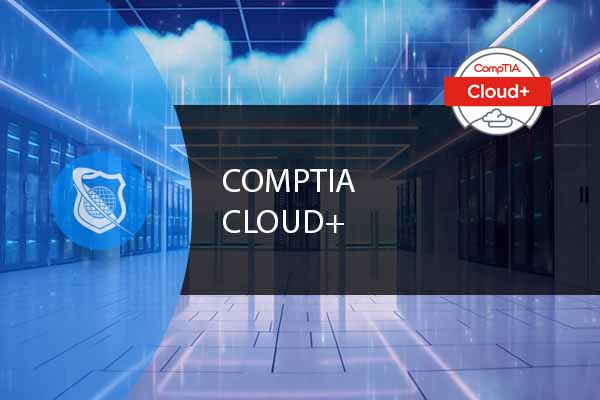$0.00
NO CREDIT CARD REQUIRED Our Free CompTIA Cloud+ Certification (based on Cloud+ CV0-001) course is a comprehensive training program that provides a comprehensive overview of cloud computing technology and covers the key concepts, models, and architectures of cloud computing.

Unlock your potential with our free CompTIA Cloud+ Certification course, a comprehensive training program that dives deep into the world of cloud computing. Understand the key concepts, models, and architectures of cloud computing without spending a dime. Grab this opportunity without needing a credit card, and start your cloud journey today1.
Our CompTIA Cloud+ Certification course offers:
The CompTIA Cloud+ Certification course, based on the Cloud+ CV0-001 syllabus, offers an in-depth look at the critical aspects of cloud computing. Ideal for IT professionals and those aiming for a career in cloud computing, the course prepares you for the CompTIA Cloud+ certification exam, validating your expertise in CompTIA’s cloud technologies1.
This course covers a broad spectrum of cloud computing topics, including virtualization, administration, security, and cloud infrastructure. Learn about various cloud architectures like public, private, and hybrid clouds, and gain hands-on experience in creating, implementing, and maintaining these architectures.
From understanding virtualization to managing cloud environments, the course prepares you for a successful career in the field. The training is perfect for IT professionals, system administrators, network administrators, and any IT experts looking to deepen their knowledge of cloud computing and earn the CompTIA Cloud+ certification.
This is a rad course that gives you a comprehensive look at cloud computing tech, covering all the key concepts, models, and structures. It’s based on the CompTIA Cloud+ CV0-001 course and aims to prepare you for the CompTIA Cloud+ certification test.
The free course is a neat 9-hour pack of knowledge. It includes 53 on-demand videos, covers 7 topics, and gives you 55 prep questions to help you get ready for that certification test
The free IT course dives into a bunch of cloud computing topics like virtualization, administration, security, and cloud infrastructure. You’ll learn about different cloud computing structures like public, private, and hybrid clouds, and how to create, use, and maintain them. You’ll also get the skills needed to set up, launch, and manage cloud computing environments using various tools and tech.
Nope, not at all. This course is totally free and doesn’t require any credit card info. Just click on ‘Buy This Training’ and you’re good to go!
Got a burning question or need a little help? No worries, mate. Just drop an email to customerservice@ituonline.com. They’re on hand Mon – Fri, 9:00am – 5:00pm ET, ready to sort things out for you. Happy learning!
David has been a professional IT instructor for the past four years for the US Army. He teaches a broad range of certification courses ranging from CompTIA, Microsoft to Cisco and EC-Council. Prior to working with the US Army, David worked as a Jr. Network Admin and Web Services Manager with KCTCS in Kentucky. He performed multiple jobs being on the IT team. Additionally, David taught part-time during the evening at the college, where he instructed on Active Directory, Introduction to Computers, and Networking. David has 18 years of IT experience, 17 professional IT certifications, and 8 years of teaching experience.
Danny Pugh is a highly experienced IT professional with a comprehensive background in Cloud Engineering. He has demonstrated an impressive career trajectory, marked by a series of significant achievements and responsibilities.
Robert is an Army Veteran who has been instructing in the IT training field for over a year. His experience with Microsoft spans over the past three years, but his decade of service in the military is where he gained his passion for and experience in the IT field. While he is knowledgeable in a variety of areas, Azure is Robert’s specialty.